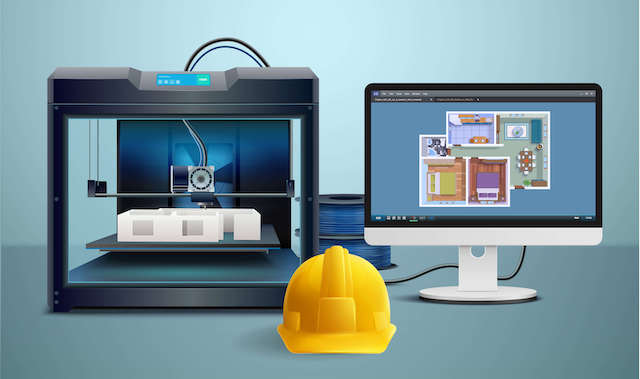What if instead of months to complete a new construction project it could be done in weeks? 3D printing can offer that kind of savings. In addition to time savings, it also reduces material costs, improves site safety, and allows designers to think more creatively.
This construction technology, which has been around for decades, is only now getting the respect it deserves in the industry. With a labor shortage crisis, contractors are looking for ways to reduce the need for skilled workers, and 3D printing fits that bill.
What is 3D printing?
3D printing is a manufacturing process that uses a “printer” to extrude materials in a layered fashion to construct whole buildings or components. The 3D printer layers materials such as concrete, polymers, or metal in an additive fashion until the component or building is complete. The printer is usually composed of a robotic arm that moves along a track and deposits material along that track. It uses electronic drafting files to control where the materials are placed.
If you’re having trouble visualizing this, think of the 3D printer like an inkjet printer. It takes messages from your computer and places ink on the paper according to the instructions it receives. A 3D printer works similarly, but in three dimensions.
3D printing isn’t new, it’s actually been going on since the 70s. As technology has grown, it has become more feasible for companies to purchase the equipment and complete entire projects with the technology.
Advantages of 3D printing in construction
3D printing offers several advantages over conventional construction techniques.
Reduces project timelines
This printing technology can construct a shell of a house in two to three days, instead of weeks for traditional construction. This speed saves on costs and allows occupants to move in sooner.
Uses less materials
Construction is a wasteful process, with as much as 30% of the materials delivered to a site ending up in the landfill. With 3D printing, there are no wasted materials since the programming tells the printer exactly how much material to place and where.
Reduced need for labor
The printing process only requires one or two people on site to monitor the printer and make sure the material is being delivered consistently. Regular construction crews usually require four people or more.
Improves site safety
With fewer workers on the site there is less chance for injuries. In addition, the printer does the heavy lifting, placing the material exactly where it needs to go without human intervention.
Reduced costs
While the printer itself can be spendy, the overall cost of a project is reduced when using 3D printing. Less labor and materials are required, and construction is completed sooner, reducing the cost of supervision and general conditions.
Reduces errors
The material is placed by a computer that isn’t subject to normal human errors. As long as the programming is correct, the materials will be placed exactly as specified. This reduces the chance of expensive rework.
Allows for more creative designs
Computers are able to handle more creative designs, like curves and angles, without difficulty. This gives designers more freedom to incorporate these elements into their designs.
3D printing applications
One of the most encouraging applications of 3D printing is in affordable housing. 3D printing houses saves time and money, making investing in these projects more attractive to developers. Some companies are using robotics and other technology, combined with modular construction practices, to modernize the construction of housing developments. With the savings created by the use of these technologies, these projects become more profitable and will attract more development firms.
3D printing can also be used to address post-disaster development needs. Because of the speed of the process and the durability of the materials used, this type of construction is perfect for rebuilding in storm ravaged areas.
Developers continue to advance the technology to expand its use on a variety of project types. With each advancement the projects get more sophisticated, and the process becomes more efficient. With substantial savings in wasted materials and unnecessary labor costs, contractors adopting this technology are able to do more with fewer costs.
The Promise of 3D-Printed Concrete
The construction industry is on the cusp of a revolutionary transformation with the advent of 3D-printed concrete technology. Traditional methods of construction, which often involve extensive labor, materials, and time, are being challenged by innovative techniques that promise to reshape the way we build our infrastructure. One such breakthrough is the use of 3D printing to create concrete structures, offering numerous advantages for efficiency, cost-effectiveness, and sustainability in infrastructure projects.
1. Unleashing Design Freedom
3D-printed concrete allows engineers and architects to break free from the constraints of traditional construction methods. With this technology, complex and intricate designs that were once deemed too challenging or expensive to execute become not only feasible but also cost-effective. Whether it’s organic shapes, curvilinear structures, or intricate latticework, 3D printing enables a new level of design freedom, giving rise to awe-inspiring and iconic infrastructure projects.
2. Rapid Construction
One of the most significant advantages of 3D-printed concrete is its ability to dramatically reduce construction timelines. Traditional construction methods often involve time-consuming tasks like formwork assembly and concrete pouring, which can take weeks or even months for large projects. 3D printing eliminates the need for much of this labor-intensive work. Large-scale structures, such as bridges or buildings, can be printed in a matter of days or weeks, not only saving time but also minimizing disruption to the surrounding environment.
3. Cost Savings and Sustainability
Reduced construction time translates into significant cost savings. With less labor, equipment, and construction materials required, 3D-printed concrete can significantly lower project budgets. Additionally, the precise nature of 3D printing minimizes material waste, contributing to sustainability efforts in the construction industry. Moreover, it allows for the use of alternative, eco-friendly construction materials, further reducing the carbon footprint of infrastructure projects.
4. Enhanced Structural Integrity
3D-printed concrete structures benefit from improved structural integrity. The precision of 3D printing technology ensures that each layer of concrete is placed with accuracy, reducing the likelihood of defects and inconsistencies that can weaken traditional structures. This level of precision can enhance the overall durability and longevity of infrastructure projects, making them more resilient to environmental factors such as earthquakes or extreme weather conditions.
5. On-Site and Off-Site Applications
3D printing technology is adaptable to various construction scenarios. It can be deployed on-site for immediate construction needs or utilized in controlled off-site environments, such as factories, for the prefabrication of modular components. This versatility allows for flexibility in project execution and can significantly streamline the construction process.
Challenges and Future Outlook
While 3D-printed concrete holds immense promise, it is not without its challenges. Scaling up the technology for large-scale infrastructure projects, ensuring the quality and consistency of printed materials, and navigating regulatory and certification hurdles are some of the obstacles that need to be overcome. However, as the technology continues to evolve and more stakeholders invest in research and development, these challenges are being addressed. With increased adoption and innovation, 3D-printed concrete has the potential to become a cornerstone of the construction industry, redefining the way we conceive, design, and build our infrastructure. 3D-printed concrete is ushering in a new era of construction, one that is marked by innovation, efficiency, and sustainability. Infrastructure projects worldwide stand to benefit from the transformative power of this technology, allowing us to construct stronger, more cost-effective, and visually stunning structures while reducing our impact on the environment. As research and development in 3D printing technology continue to advance, the future of infrastructure looks brighter than ever.
3D printing construction uses
There are several construction situations where you can use 3D printing. Here are a few examples:
Completing a full job
3D printers can create entire buildings, including houses and offices. This is typically more cost-effective, better for the environment and quicker than traditional construction. Towns may also consider using 3D printing for other infrastructure needs such as stairways, bridges, railings and other community projects.
Creating prototypes
Prototypes are preliminary models of structures that give people an example of what something could look like. For example, if a company wants to build a new office, a 3D printer could create a prototype for the office much easier than a construction company could level the ground, hire labor and prepare full construction sites. Although there’s still a cost, 3D printing provides clients with the ability to create these prototypes much quicker and at a lower price than constructing full prototypes through traditional building methods.




